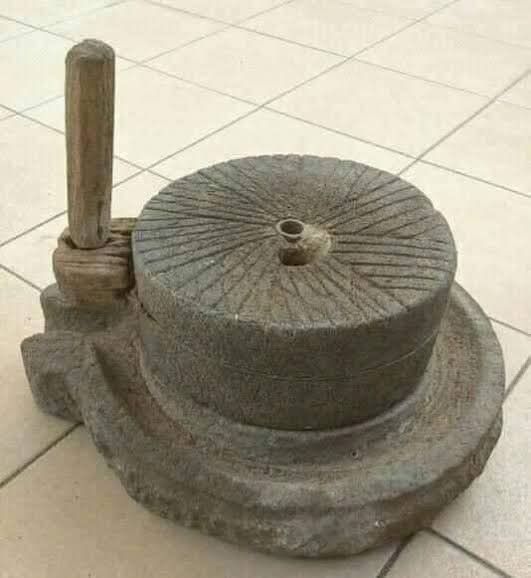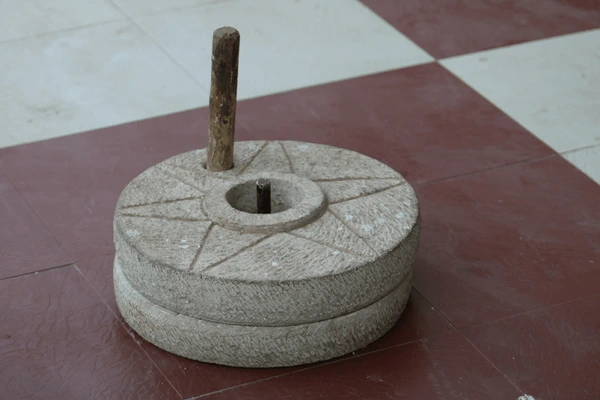The Ancient Stone Grinder: A Silent Witness to a Forgotten Era
Throughout history, certain tools have been designed to withstand the test of time. Among these tools, the ancient stone grinder stands as a testament to the ingenuity and persistence of past generations. The stone grinder, an integral part of traditional life, has played a pivotal role in communities across Asia, including Vietnam. Today, it serves as a fragment of a life long gone, a quiet observer of an era when life moved at a different pace. But what was its true purpose, and why does it still intrigue us today?
A Glimpse into the Past: The Craftsmanship of the Stone Grinder
The stone grinder consists of two round stones that fit together, one on top of the other. The top stone features a wooden handle for turning, while the bottom stone remains fixed in place. The most distinctive feature of this tool is the small hole in the center, which is used to pour ingredients such as rice, soybeans, or grains. As the top stone is turned by the handle, the two stones grind the ingredients between them, and the finely ground substance flows out through a circular groove at the bottom.

The Materials and Design: Durability Meets Simplicity
Crafted from hard mountain stone, the stone grinder was designed to endure the rigors of daily use. The stones’ rough surface and tight fit made them ideal for grinding grains and beans into flour, a process that was once central to the preparation of food in many rural households. The design may appear simple, but its efficiency and durability are the result of centuries of refinement.
While modern machines have replaced this ancient tool in many places, the stone grinder continues to evoke a sense of nostalgia for those who remember the rhythmic sound of grinding in the early morning hours. It is a relic of a time when everything, from food preparation to daily chores, was done by hand.
From Past to Present: The Role of the Stone Grinder
Used primarily in rural Asia, the stone grinder was once a vital tool in the daily life of countless families. In countries like Vietnam, it was common to see this tool in the homes of farmers and artisans. Before the advent of modern grinders and mills, the stone grinder was indispensable for tasks like grinding rice into flour, grinding soybeans for making cakes, and processing grains into flour for various food products.
Video :Millstones – Wheat Flour Milling
Its role was not merely functional; it also served as a community hub. Families often gathered around the stone grinder, turning it together, as a shared activity that brought them closer. The rhythmic turning of the handle, combined with the soft crunching sound, marked the beginning of the day for many rural families.
Cultural Significance: More Than Just a Tool
The stone grinder holds more than just utilitarian value; it is also a cultural symbol. For many generations, the sound of the stone grinder echoed through villages, reminding people of the hard work and perseverance of their ancestors. In this sense, the stone grinder transcends its role as a simple tool—it represents the values of dedication, patience, and the passing down of knowledge from one generation to the next.
In Vietnam, the grinder is often associated with memories of childhood. It was common for children to learn how to grind grains using the stone grinder, a rite of passage that connected them with their family’s traditions. The tool became a symbol of rural life, with its familiar sounds providing comfort and continuity.
The Decline of the Stone Grinder: A Shift to Modernity
As technology advanced, the stone grinder gradually became obsolete. Modern grinders and milling machines, capable of processing grains more efficiently, replaced the traditional stone grinder. The pace of life began to change, and people moved away from the rural lifestyle that had once defined their communities.

Despite its decline, the stone grinder continues to be cherished as a symbol of the past. It can still be found in many rural homes, as well as in museums and cultural exhibitions, where it is preserved as a relic of a bygone era. For some, the stone grinder is a reminder of simpler times, a connection to their roots and their heritage.
The Legacy of the Stone Grinder: A Symbol of Resilience
While the stone grinder may no longer be a fixture in everyday life, its legacy endures. The tool’s design, simplicity, and ability to endure through generations speak to the resilience of the people who used it. In a world increasingly dominated by modern technology, the stone grinder serves as a reminder of the value of craftsmanship and the importance of preserving traditions.
Moreover, the stone grinder’s cultural significance cannot be overstated. It symbolizes the strength and perseverance of the people who relied on it for their daily sustenance. Its quiet presence continues to inspire respect for the ingenuity of past generations and the timeless connection between people and the tools they create.
The Stone Grinder Today: A Nostalgic Artifact
Today, the stone grinder is more than just an old tool—it’s a piece of history. It has become a symbol of rural life and a reminder of the importance of sustainable living. While modern conveniences have replaced many of the old methods, the stone grinder’s legacy endures as a symbol of the ingenuity and hard work of past generations.
Video :Matcha Stone Mill Grinder , Mr. Ito – AOI Tea Company
Many collectors and history enthusiasts seek out stone grinders as a way to connect with the past. They appreciate the tool’s craftsmanship and its role in shaping the way people lived for centuries. Whether displayed in homes, museums, or cultural exhibits, the stone grinder continues to capture the imagination of those who appreciate the beauty of old things.
Conclusion: The Enduring Charm of the Stone Grinder
The stone grinder is more than just a tool—it’s a window into the past, a testament to the resilience and ingenuity of those who used it. From its simple design to its cultural significance, the stone grinder tells a story of hard work, tradition, and community. Though modern technology has rendered it obsolete in everyday life, the legacy of the stone grinder continues to endure, reminding us of the timeless value of craftsmanship, simplicity, and the passing down of traditions from one generation to the next.
It’s a piece of history that holds a special place in the hearts of those who recognize its significance, and its story will continue to captivate for generations to come.